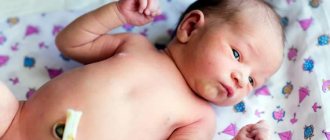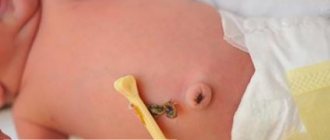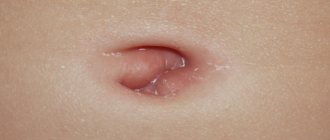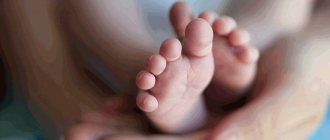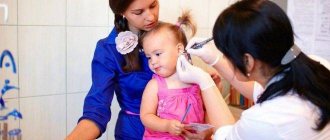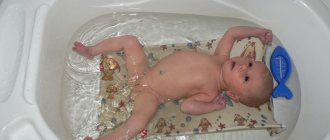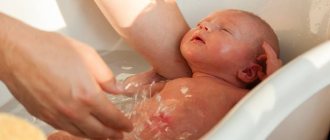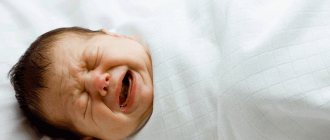Newborn babies require special care. They should consume enough breast milk, sleep regularly and get enough fresh air. An important point is also the implementation of hygiene procedures. In the first days of a child’s life, young parents are interested in the issue related to the care of the baby’s navel. As you know, after childbirth, a special clothespin is attached to it, which falls off over time.
How long does it take for a newborn's belly button to heal?
The umbilical cord is cut immediately after the baby is born.
Only a small part of it, about 2 cm long, remains. After the wound heals, a neat navel remains in this place. To ensure that the process goes quickly and without complications, even in the maternity hospital, the mother will be shown and told what caring for a newborn’s navel consists of and what products are best to use. The treatment process is simple, but if parents are afraid of harm, they often don't know where to start. Normally, the navel heals in 3–4 weeks, but the final period depends on the individual characteristics of the body. Healing occurs in stages:
- Within 3–5 days after birth, the umbilical cord, which resembles a knot, dries out and falls off on its own.
- Over the next 3 weeks, the navel heals similarly to a classic deep wound, occasionally bleeding (in case of severe bleeding, consult a doctor).
- After 4 weeks, the wound heals. If this does not happen, you should visit your pediatrician.
Treating the navel and bathing a newborn with a clothespin
Occasionally, a baby is discharged from the maternity hospital with a “clothespin” on his tummy. This is due to the fact that the drying process of the umbilical cord varies from person to person and can take 4-10 days. Don’t let this bother you; in due time, the clamp will fall off in the area with the dried umbilical cord stump. Do not attempt surgical removal yourself, as this may result in serious infection.
Stages of careful care of the umbilical wound
Fast healing depends, not least of all, on proper care of the newborn’s umbilical cord. We are talking not only about daily treatment, but also about the rules of bathing and dressing, as well as the choice of clothing.
To care for the umbilical wound of a newborn, prepare a sterile pipette and cotton swabs in advance. You will also need chlorhexidine - it is an effective, odorless and colorless antiseptic. You can also use 3% hydrogen peroxide. The doctor will tell you which remedies and how to use them.
Standardly, in the maternity hospital, the wound is treated with hydrogen peroxide, which causes the umbilical cord to dry out. If discharge from the maternity hospital occurs before the umbilical cord falls off, parents carry out further activities at home.
Treatment of the navel is carried out in the evening after bathing the baby. Before the procedure, you need to wash your hands thoroughly with soap. Then spread a disposable absorbent diaper on a table or other flat and safe surface and place the baby on his back. The further algorithm for caring for a newborn’s navel includes the following steps:
- Use your thumb and index finger to gently stretch the umbilical wound.
- Apply 3% hydrogen peroxide to the open wound and leave for a couple of minutes. The foam that appears indicates that there are particles of blood in the wound.
- Carefully remove dried particles with a cotton swab.
- Dry the wound with a cotton swab or cotton pad held with tweezers.
- Dip a clean cotton swab in chlorhexidine and treat the wound.
- If a crust has formed on the wound, do not remove it: it will soon fall off on its own.
- Leave the child under supervision and wash hands with soap.
- Dress the baby in a vest made of natural fabric that does not compress the body. Before this, clothes are thoroughly washed, dried and ironed to prevent germs from getting into the open wound.
In the absence of complications, a bandage is not applied to the wound. If a diaper is used, it should be fastened below the wound (there are models with a cutout at the navel).
How to care for a newborn's belly button after a clothespin falls off
The fetus in the womb receives nutrition through the umbilical cord.
As you know, for the entire 9 months that the fetus is in the womb, the baby receives its main nutrition through the umbilical cord. During childbirth, it is cut off, and the remainder is fixed on the child in a certain way.
Obstetricians-gynecologists do this using a special clothespin or plastic clamp.
When does the clothespin come off?
The clothespin from the navel disappears 5-10 days after birth.
In the first days of life, the child’s navel begins to gradually grow over. At this time, parents should wait for the clothespin to fall off.
This can happen for some on the 5th, for others on the 7th or 10th day. There are times when it disappears only after two weeks.
Proper processing
All these days until the clothespin falls off, parents must always treat the navel so that various microbes do not get into it. At this time, the baby's tummy is very vulnerable.
A solution of hydrogen peroxide is used to treat the navel.
To treat the tummy with a clothespin, use a 3% solution of hydrogen peroxide and brilliant green . Apply the products using a cotton pad. Hydrogen peroxide should be instilled into the wound itself with a pipette.
Available processing tools and features
In the process of caring for the umbilical wound of a newborn, it is necessary to adhere to all recommendations received in the maternity hospital and from the local pediatrician. The dried umbilical cord is not removed: it must fall off on its own. It is important to avoid rubbing and squeezing the umbilical wound, otherwise infection and inflammation may occur. In the air, any skin damage heals faster and better. Therefore, unless recommended by a doctor, you should not stick a patch on your navel or lubricate it with fatty creams.
Bathing a child in a bath is carried out after the umbilical cord falls off. Until this point, hygiene comes down to wiping with a damp cloth and washing. After any water procedures, standard care is carried out for the newborn’s navel - dried and treated.
When can you bathe your baby?
You can start bathing your baby only after the clothespin falls off from the navel. The first water procedures are carried out, as a rule, no earlier than 14–21 days from the date of birth.
If you are going to bathe your baby for the first time, then take care of a bath for him. The water must be strictly warm and boiled. When bathing, you should use only baby hygiene products designed specifically for infants.
The water in the bath should be boiled and not hot.
Chamomile decoction
To make the navel heal faster, you can add chamomile decoction to the bath.
You can also use it to make lotions in the umbilical area. They are applied after bathing; they are also suitable for celandine decoction. For better wound healing, pediatricians also recommend using potassium permanganate . As for chamomile decoction, it should be used no more than 2 times every 7 days, since frequent use can dry out children's skin and cause an allergic reaction.
You can make lotions for the navel using chamomile decoction.
After bathing, do not forget to treat the belly button, from which the clothespin has recently fallen off, with the solutions mentioned above. You can start processing 1–1.5 hours after bathing, if you also use lotions from decoctions. The wound should be treated for an average of 4 weeks. The need for this procedure and its duration are discussed with the treating pediatrician.
What effect does a hygienic bath give?
Up to six months, the baby is bathed daily, then once every two days until he is one year old. Until the umbilical wound heals, the baby’s bathing container is washed with soap, and a couple of potassium permanganate crystals are added to the water. Excessive concentration provokes a burn, so the water should be barely pink. When the wound heals, potassium permanganate will not be needed.
To increase the therapeutic effect of a hygienic bath, when caring for a newborn’s umbilical cord, you can add a decoction of herbs with antiseptic properties to the water. It could be calendula, oak bark, chamomile. Do not use soap; just gently wash the folds of skin on the baby’s body with your hand or a soft sponge. Instead of drying the baby, wrap it in a flannelette diaper or soft towel. Next, standard care for the newborn’s navel is applied according to the instructions described above.
Other means
You can use many other antiseptics for this procedure. Here's how to treat a newborn's navel, besides brilliant green:
- Chlorophyllipt.
- Manganese.
- Fukortsin.
- Chlorhexidine.
- Iodine.
- Furacilin.
- Streptocide.
- Tincture of calendula.
Now you know what can be used to treat a newborn’s navel other than brilliant green; you can read more about these substances in other articles on our website.
What are the problems with navel healing?
Even in cases where parents flawlessly follow all recommendations for caring for the umbilical wound of a newborn, problems are possible:
- the wound does not heal within the prescribed period;
- redness and swelling are visible around the navel;
- the nodule does not dry out, there is discharge;
- the wound festers and has an unpleasant odor.
All of these problems require consultation with a pediatrician. Poor healing can be caused by individual characteristics (an umbilical cord that is too thick takes longer to dry out), weakened immunity (premature babies), an umbilical hernia (due to frequent loud crying), or an infection. Depending on the cause, medications will be prescribed and proper treatment of the wound will be recommended, possibly at a medical facility.
In most cases, umbilical wounds in children heal well and quickly. If everything is done correctly and carefully, there will be no complications. If something worries you, you can always consult a pediatrician.
The baby's belly button is bleeding after the clothespin falls off: what to do?
Often young parents complain to pediatricians about the same problem - blood in the child’s navel after a clothespin falls off.
This symptom happens, unfortunately, often, but, as a rule, does not represent anything terrible. Causes of minor bleeding:
- burns of children's skin with antiseptic agents due to frequent use of solutions or their use in large quantities;
- mechanical trauma during navel treatment;
- mechanical injuries as a result of playing, holding a baby, etc.;
- rupture of the skin of the navel due to tension in the abdominal muscles due to overexertion (crying, pushing to the toilet, etc.).
If the navel bleeds, this is not a painful symptom and does not pose a danger.
How to avoid?
To avoid this symptom, try to treat your baby’s tummy no more than 1-2 times a day.
Use hydrogen peroxide 3% and brilliant green. Or you can replace brilliant green with potassium permanganate or chlorophyllipt. Under no circumstances use more than two compounds at the same time, as this may result in a burn.
When treating a navel wound, be extremely careful and attentive . We repeat once again that under no circumstances should you pick at it or forcefully remove dried residues that fall off over time.
Hold a newborn baby only during feeding. These days he needs peace and normal sleep. If you play with it and move a lot, then the belly button will, firstly, take longer to heal, and secondly, the baby will often be capricious.
A newborn baby should be held only when it is time to feed him.
Rules of care for caring parents
Overly worried parents can cover the navel with a natural, clean cloth, but only so that it lies loosely. If the wound becomes dirty, clean it with sterile water and soap. In rare cases where sanitary conditions leave much to be desired, WHO recommends the use of chlorhexidine for treatment. But this is an exception to the rule for those who do not maintain hygienic conditions in their own home.
For most parents, it will be enough to give the baby air baths and bend the edge of the diaper so that it does not cover the navel area. Until the newborn's belly button has healed completely, there is no need to bathe the child in the bath. You just need to wash your child regularly, trying to prevent water from getting into the wound area.
An already healed navel in a newborn does not require any treatment. When the wound heals, you can safely bathe your baby in the bathroom and not worry about the umbilical area. This will happen in the first month of the baby’s life.
